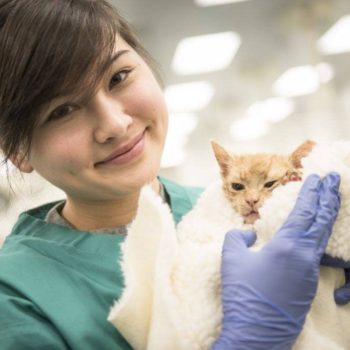No one wants to see pets born who will end up homeless or unwanted. But in areas where veterinary practices are already facing a tough economic landscape, the opening of nonprofit spay/neuter clinics can feel threatening. Are those fears realistic? A new study published in the Journal of the American Veterinary Medical Association suggests the answer is no.
Researchers, including Dr. Julie Levy of the Maddie’s Shelter Medicine Program at the University of Florida and Dr. Janet Scarlett, former Director of the Maddie’s Shelter Medicine Program at Cornell University, surveyed 3,768 owners of 2,154 dogs and 1,902 cats admitted to 22 nonprofit spay-neuter clinics across the United States, and found that most of the pets sterilized in these clinics were owned by families earning less than $30,000 annually and had not seen a veterinarian in the previous year (or ever).
Not only that, but many of the pets — 81 percent of cats and 32 percent of dogs – had never even been vaccinated against rabies.
Access to affordable veterinary care is a critical component of keeping pets in their homes and out of shelters. When that veterinary care is spaying and neutering, it’s actually keeping multiple generations of pets out of shelters, reducing strain on the shelter system, improving the lives of pet owners, and protecting public and animal health through vaccination.
Nonprofit clinics do this by serving the very people whose animals are at greatest risk of reproduction, and who are not already seeking the care of a private practice veterinarian due to income, transportation and other constraints.
Commenting in the study press release, Dr. Michael Blackwell, Director of the Program for Pet Health Equity, said:
There are more than 23 million dogs and cats in families with limited means to pay for veterinary care. The lack of access to veterinary care results in prolonged illnesses and recovery, or relinquishment to the animal sheltering community, or worse yet, euthanasia, thus breaking the human-animal bond. These families need and deserve health care for all members, human and animal. Through better collaboration and attention to this national crisis, we can improve overall family health and wellbeing. Keeping families together builds healthier communities.
Sara C. White DVM, MSc; Janet M. Scarlett DVM, MPH, PhD; Julie K. Levy DVM, PhD. Characteristics of clients and animals served by high-volume, stationary, nonprofit spay-neuter clinics. Journal of the American Veterinary Medical Association; September 15, 2018, Vol. 253, No. 6, Pages 737-745; https://doi.org/10.2460/javma.253.6.737

